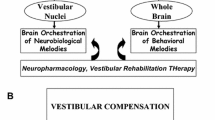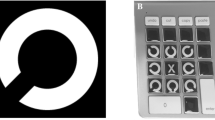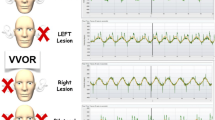Abstract
The aim of this study was to establish the effect of vestibular lesion on vestibular imagery. Subjects were required to estimate verbally their passively travelled rotation angles in complete darkness, i.e., to activate vestibular imagery. During motion, the vestibulo-ocular reflex (VOR) was measured. Thus, we examined the coherence between the vestibulo-ocular reflex and self-rotation imagery, with vestibular-lesioned patients and healthy participants. Unilateral acute and chronic patients, bilateral patients, and healthy subjects were compared. The stimulus was a sequence of eight successive passive rotations, with four amplitudes (from 90° to 360°) in two directions. The VOR gain was lower in patients with unilateral lesions, for ipsilateral rotations. The healthy subjects had the highest gain and the bilateral group the lowest, on both rotation sides. Thanks to vestibular compensation after acute unilateral neuritis, the VOR gain increased in lesion side and decreased in healthy side, resulting in a similar gain in both sides. A deficit of vestibular imagery was found exclusively in patients with bilateral hyporeflexia, on both sides. The performance in vestibular imagery was good in the control group and correct in the unilateral patients. Finally, we found a significant correlation between the efficiency of the VOR and that of vestibular imagery, exclusively in the bilateral patients. The present study shows the complex relationship between vestibular imagery and the VOR. This imagery test contributes to another assessment of the spatial handicap of vestibular patients. It seems particularly interesting for patients with bilateral canal paresis and could be used to confirm this diagnosis.



Similar content being viewed by others
References
Allum JH, Ledin T (1999) Recovery of vestibulo-ocular reflex-function in subjects with an acute unilateral peripheral vestibular deficit. J Vestib Res 9:135–144
Baloh RW, Honrubia V, Yee RD, Hess K (1984) Changes in the human vestibulo-ocular reflex after loss of peripheral sensitivity. Ann Neurol 2:222–228
Becker W, Jurgens R, Boss T (2000) Vestibular perception of self-rotation in different postures: a comparison between sitting and standing subjects. Exp Brain Res 131:468–476
Becker W, Nasios G, Raab S, Jurgens R (2002) Fusion of vestibular and podokinesthetic information during self-turning towards instructed targets. Exp Brain Res 144:458–474
Besnard S, Lopez C, Brandt T, Denise P, Smith PF (2015) Editorial: the vestibular system in cognitive and memory processes in mammalians. Front Integr Neurosci 9:55
Bigelow RT, Agrawal Y (2015) Vestibular involvement in cognition: visuospatial ability, attention, executive function, and memory. J Vestib Res 25:73–89
Clement G, Tilikete C, Courjon JH (2008) Retention of habituation of vestibulo-ocular reflex and sensation of rotation in humans. Exp Brain Res 190:307–315
Cohen SB, Israël I (2004) Vestibular system and spatial orientation. J Vestib Res 14(2–3):235
Collewijn H (1989) The vestibulo-ocular reflex: an outdated concept. Progr Brain Res 80:197–209
Cousins S, Kaski D, Cutfield N, Seemungal B, Golding JF, Gresty M, Glasauer S, Bronstein AM (2013) Vestibular perception following acute unilateral vestibular lesions. PLoS One 8:e61862
Etienne AS, Jeffery KJ (2004) Path integration in mammals. Hippocampus 14:180–192
Fetter M, Dichgans J (1990) Adaptive mechanisms of VOR compensation after unilateral peripheral vestibular lesions in humans. J Vestib Res 1:9–22
Guedry FE (1974) Psychophysics of vestibular sensation. In: Kornhuber HH (ed) Handbook of sensory physiology, vol VI/2. Springer, Berlin, pp 3–154
Halmagyi GM, Curthoys IS, Cremer PD, Henderson CJ, Todd MJ, Staples MJ, D’Cruz DM (1990) The human horizontal vestibulo-ocular reflex in response to high-acceleration stimulation before and after unilateral vestibular neurectomy. Exp Brain Res 81:479–490
Hitier M, Besnard S, Smith PF (2014) Vestibular pathways involved in cognition. Front Integr Neurosci 8:59
Israël I, Bronstein A, Kanayama R, Faldon M, Gresty MA (1996) Visual and vestibular factors influencing vestibular “navigation”. Exp Brain Res 112:411–419
Israël I, Ventre-Dominey J, Denise P (1999) Vestibular information contributes to update retinotopic maps. NeuroReport 10:3479–3483
Israël I, Capelli A, Sable D, Laurent C, Lecoq C, Bredin J (2004) Multifactorial interactions involved in linear self-transport distance estimate: a place for time. Int J Psychophysiol 53:21–28
Israël I, Siegler I, Rivaud-Pechoux S, Gaymard B, Leboucher P, Ehrette M, Berthoz A, Pierrot-Deseilligny C, Flash T (2006) Reproduction of self-rotation duration. Neurosci Lett 402:244–248
Jandle NM, Sprenger A, Wojak JF, Gottlich M, Munte TF, Kramer UM, Helmchen C (2015) Dissociable cerebellar activity during spatial navigation and visual memory in bilateral vestibular failure. Neuroscience 305:257–267
Kanayama R, Bronstein A, Gresty MA, Brookes GB, Faldon ME, Nakamura T (1995) Perceptual studies in patients with vestibular neurectomy. Acta Otolaryngol (Stockh) 115(Suppl. 520 PT 2):408–411
Kyriakareli A, Cousins S, Pettorossi VE, Bronstein AM (2013) Effect of transcranial direct current stimulation on vestibular-ocular and vestibulo-perceptual thresholds. NeuroReport 24:808–812
Lopez C (2013) A neuroscientific account of how vestibular disorders impair bodily self-consciousness. Front Integr Neurosci 7:91
Lopez C, Schreyer HM, Preuss N, Mast FW (2012) Vestibular stimulation modifies the body schema. Neuropsychologia 50:1830–1837
Maire R, Van Melle G (2000) Dynamic asymmetry of the vestibulo-ocular reflex in unilateral peripheral vestibular and cochleovestibular loss. Laryngoscope 110:256–263
Merfeld DM, Park S, Gianna-Poulin C, Black FO, Wood S (2005) Vestibular perception and action employ qualitatively different mechanisms. II. VOR and perceptual responses during combined Tilt&Translation. J Neurophysiol 94:199–205
Mergner T, Rumberger A, Beckert W (1996) Is perceived angular displacement the time integral of perceived angular velocity? Brain Res Bull 40:467–470
Metcalfe T, Gresty MA (1992) Self-controlled reorienting movements in response to rotational displacements in normal subjects and patients with labyrinthine disease. Ann N Y Acad Sci 656:695–698
Mittelstaedt ML, Mittelstaedt H (1980) Homing by path integration in a mammal. Naturwiss 67:566–567
Nakamura T, Bronstein A (1995) The perception of head and neck angular displacement in normal and labyrinthine-defective subjects—a quantitative study using a ‘remembered saccade’ technique. Brain 118:1157–1168
Okada T, Grunfeld E, Shallo-Hoffmann J, Bronstein A (1999) Vestibular perception of angular velocity in normal subjects and in patients with congenital nystagmus. Brain 122(Pt 7):1293–1303
Raphan T, Matsuo V, Cohen B (1979) Velocity storage in the vestibulo-ocular reflex arc (VOR). Exp Brain Res 35:229–248
Seemungal BM, Gunaratne IA, Fleming IO, Gresty MA, Bronstein AM (2004) Perceptual and nystagmic thresholds of vestibular function in yaw. J Vestib Res 14:461–466
Young LR (1984) Perception of the body in space: mechanisms. In: Darian-Smith I (ed) Handbook of Physiology—the nervous system III. American Physiological Society, Bethesda, pp 1023–1066
Acknowledgements
Alain Berthoz, professor at the Collège de France, is respectfully acknowledged for allowing us to realise this study with his motorised Barany chair. The anonymous reviewer who amply contributed to improve the first version of this paper is gratefully acknowledged.
Author information
Authors and Affiliations
Corresponding author
Rights and permissions
About this article
Cite this article
Cohen, B.S., Provasi, J., Leboucher, P. et al. Effects of vestibular disorders on vestibular reflex and imagery. Exp Brain Res 235, 2181–2188 (2017). https://doi.org/10.1007/s00221-017-4959-7
Received:
Accepted:
Published:
Issue Date:
DOI: https://doi.org/10.1007/s00221-017-4959-7




